Blog po polsku/in Polish: http://ontario-nature-polish.blogspot.ca/2012/08/na-kanu-na-zatoce-georgian-bay-kolo.html
Having just completed our 6-day long canoe trip on the Key River, Georgian Bay and in French River Provincial Park (see blog http://ontario-nature.blogspot.ca/2012/08/canoeing-on-key-river-and-georgian-bay.html), we drove to the parking at the Chikanishing Creek. The weather was not very good, it seemed like it might rain—as well as it was windy, yet it was getting a little late (04:00 pm) and we did not have time to wait it out. There were a few kayakers (day-trippers) and later we had a chat with a nice gentleman who took a couple of photos of us. We departed at 04:30 pm, thus starting a new leg of our excursion! Just before our departure, it started raining. Undeterred, we donned our rain suits and set out.
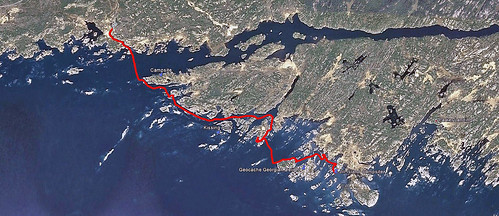 |
| Our route from the Chikanishing River to our campsite on Jill Island |
 |
| The weather was our main concern... |
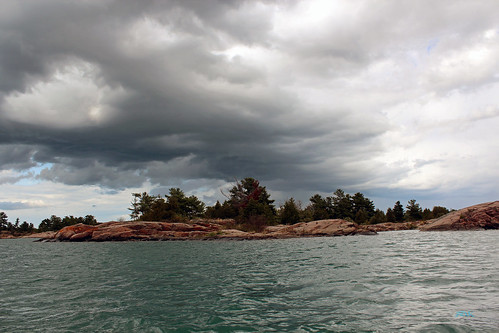 |
| It was raining, windy and the waves made it very difficult for us to paddle |
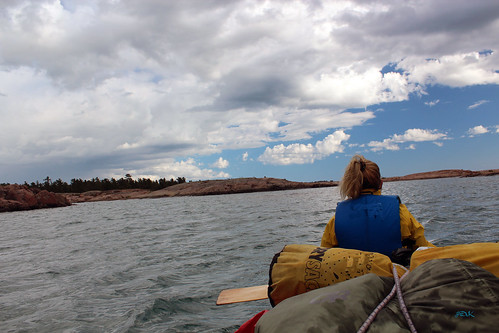 |
| Looking for a campsite |
There was a campsite on this island, accessible from the bay: last year, when we were camping on Solomon Island, a bunch of guys had camped on that very campsite and we could see them from afar. Catherine went ashore to examine the site, but said it was too far from the shore and it would require us to carry our stuff relatively far. Since it was raining again—and Catherine was getting cold—we were very eager to find a decent campsite. We even considered staying on our last year’s spot on Solomon Island (it was an awesome campsite!), yet a group of girls were already camping there. Catherine talked to them for a while and we paddled off in search of a campsite.
 |
| Finally, a double rainbow appeared in the sky |
We paddled among numerous islands and rocks and finally reached a large hilly island, with a shore made of flat rock, perfect for a campsite. According to my map, it was Jill Island, although I do not think it was an island anymore—the existing isthmus was probably very shallow and overgrown by now. We saw plenty of small, picturesque rocky islands popping up from the water; Solomon Island and the distinctive pine that appeared in many of my photos last year loomed not far from us, as well as we could observe Blockbuster Island, Lowe Island and even some Fox Islands. Although it stopped raining and a beautiful, double rainbow appeared in the sky, there were also black clouds here and there, with distinctive ‘descending’ rain patterns. Very quickly I set up the tent on the barren rock, using plenty of rocks as pegs—it was windy and we had to secure it so that it would not be blown away! Later I built a fire pit—due to the unrelenting wind, I had to make sure it was as sheltered as possible; luckily, there were plenty of flat rocks which made perfect shields. Later we went for a short jaunt around the campsite and climbed the hill. The view was striking, we even saw part of West Fox Island where we camped last year. There were several fire pits, but they were in areas so exposed to the wind that it was impossible to use them.
That evening we genuinely enjoyed the campfire—after all, altogether we paddled 29 km and survived very bad weather. When it got dark, the sky became very clear and I took several night photos—the moon, in its waxing crescent phase, appeared for a short time after the sunset and then was gone, so the stars and the Milky Way were perfectly visible. Several times we saw satellites, quickly crisscrossing the sky—one of those objects was extraordinarily bright—I suspected it was the International Space Station. The girls on the Solomon Island campsite were shooting fireworks as well as released a bright lantern that slowly floated up in the air and finally vanished beyond the forest canopy.
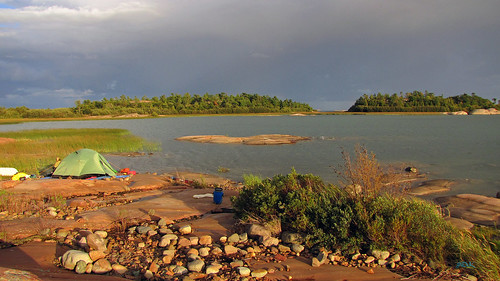 |
| Our awesome campsite on Jill Island! (N45 57.980 W81 21.005) |
 |
| View from the top of Jill Island. Very distinctive pine tree located vis-a-vis the Solomon Island campsite we stayed on in 2011--we could see it from our campsite on Jill Island too! |
“They must be local fishermen”, I said to Catherine, “and must know the area quite well. But even if I knew it very well, I’d be afraid to go so fast, there are so many rocks everywhere.”
In literally two or three seconds after I uttered those prophetic words, we heard a dull thump, the sound of the engine suddenly died off—and only after a few minutes the boat started to move, albeit very slowly and quietly (maybe this time it was using a small electric trolling motor).
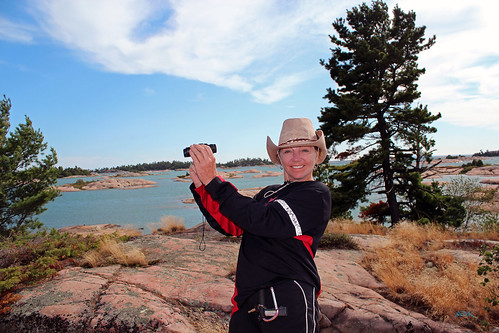 |
| Catherine on the top of Jill Island |
A few weeks before our trip I got interested in “Geocaching”, an outdoor recreational activity in which the participants use a Global Positioning System (GPS) receiver or mobile device and other navigational techniques to hide and seek containers, called “geocaches” or “caches”, anywhere in the world. Initially I wanted to hide a few caches around the Key River and Philip Edward Island, but when I realized that once I did it, I would have an obligation to maintain my caches, I decided against it. However, there were two geocaches hidden ‘just around the corner’—one on Solomon Island, another one on Martins Island (one of the Fox Islands). Catherina also got curious about this activity and we decided to go to Solomon Island and find it.
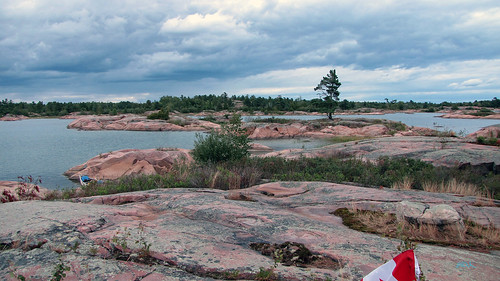 |
| Our 2011 campsite on Solomon Island |
First of all, we paddled to a small bay just across Solomon Island where a few days ago we had seen a house boat docked there. Indeed, it was still there and it was certainly not going anywhere! It was not a typical houseboat—somebody (probably he also owned property there) made a simple house on aluminum floats and moved it to the bay when the water level was much higher—now it was almost resting on the rocks. We took a few photos of this inventive creation and paddled to Solomon Island. The girls had been gone, leaving behind a Canadian flag. So, we re-visited our old campsite and took a few photos. We also noticed a few people camping on Le Hayes Island.
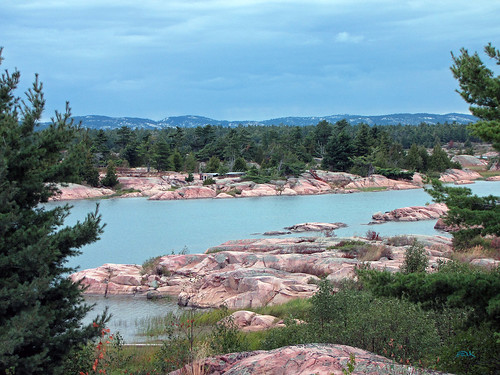 |
| Spectacular view from the summit of Solomon Island! |
According to my GPS unit, the geocache (called ‘Georgian Bay Delight’) was located in the middle of the island, on its highest point. We slowly made our way up, carefully hiking on rocks and finally reached the summit. WOW, what a magnificent, spectacular 360 degree view!!! I started to take a lot of photographs and had almost forgotten about finding the geocache. Anyway, it was supposed to be in the island’s highest location, where a few pine trees were growing (we could see them from our campsite). Catherine and I kept looking and looking… and finally I found it! It was a perfect location to place a geocache—even if I had not found it, the view was priceless—it was like being in some kind of fantasy land, surrounded by multitudes of pinkish rocks and islands, with wind-swept pines everywhere. Not only did we see our campsite, but also the Foxes, Philip Edward Island, the majestic La Cloche Mountains with their characteristic white quartz resembling snow and the mountains’ most prominent peaks, the Crack and Silver Peak; the town of Killarney, Manitoulin Island and probably the shores along the mouth(s) of the French River. Just meters from the geocache location we found a poignant monument dedicated to “Rocky, the canoe dog”.
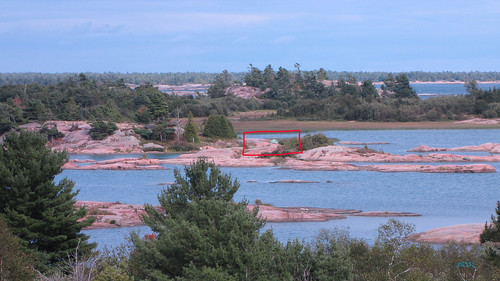 |
| View from the top of Solomon Island--we could even see our campsite on Jill Island! |
When we circumnavigated Philip Edward Island 2 years ago, in August, 2010, in my blog about that trip (http://ontario-nature.blogspot.ca/2010/08/canoeing-around-philip-edward-island.html) I quoted passages from a book by Anna Brownell Jameson (1794-1860), a British writer, who in 1837 travelled, mainly in a canoe, from Sault Ste. Marie to Toronto, visiting such places as Manitoulin Island and the site of the town of Killarney, as well as along the shores of Georgian Bay, just south of Philip Edward Island and near the mouth of the French River. During her extensive travels she was thrown “into scenes and regions hitherto undescribed by any traveler and into relations with the Indian tribes such as few European women of refined and civilized habits have ever risked and none have recorded”.
The result was her book titled “Winter Studies and Summer Rambles in Canada”, published after her return to England. This book gives a very vivid picture of the area, people and customs of the time.
The result was her book titled “Winter Studies and Summer Rambles in Canada”, published after her return to England. This book gives a very vivid picture of the area, people and customs of the time.
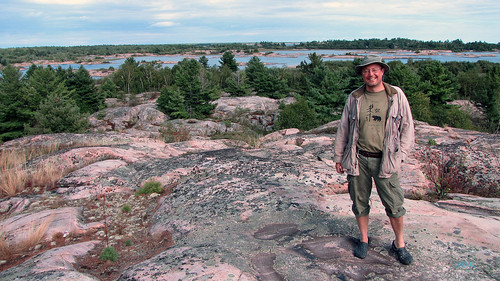 |
| On the top of Solomon Island, after finding the geocache |
While travelling south of Philip Edward Island towards the south, Anna Jameson also appreciated the beauty of the area:
“This day we had a most delightful run among hundreds of islands; sometimes darting through narrow rocky channels, so narrow that I could not see the water on either side of the canoe; and then emerging, we glided through vast fields of white water-lilies; it was perpetual variety, perpetual beauty, perpetual delight and enchantment, from hour to hour. The men sang their gay French songs, the other canoe joining in the chorus”.
And later, she wrote:
“We landed at sunset on a flat ledge of rock, free from bushes, which we avoided as much as possible for fear of mosquitoes and rattle-snakes; and while the men pitched the marquees and cooked supper, I walked and mused. I wish I could give you the least idea of the beauty of this evening; but while I try to put in words what was before me, the sense of its ineffable loveliness overpowers me now, even as it did then. (...) The lake lay weltering under the western sky like a bath of molten gold; the rocky islands which studded its surface were of a dense purple, except where their edges seemed fringed with fire. They assumed to the visionary eye, strange forms; some were like great horned beetles, some like turtles, some like crocodiles, and some like sleeping whales and winged fishes; the foliage upon them resembled dorsal fins, and sometimes tufts of feathers. Then, as the purple shadows came darkening from the east, the young crescent moon showed herself, flinging a paly splendor over the water. I remember standing on the shore, ‘my spirits as in a dream were all bound up’—overcome by such an intense feeling of the beautiful—such a deep adoration for the power that had created it, I must have suffocated if—
“This day we had a most delightful run among hundreds of islands; sometimes darting through narrow rocky channels, so narrow that I could not see the water on either side of the canoe; and then emerging, we glided through vast fields of white water-lilies; it was perpetual variety, perpetual beauty, perpetual delight and enchantment, from hour to hour. The men sang their gay French songs, the other canoe joining in the chorus”.
And later, she wrote:
“We landed at sunset on a flat ledge of rock, free from bushes, which we avoided as much as possible for fear of mosquitoes and rattle-snakes; and while the men pitched the marquees and cooked supper, I walked and mused. I wish I could give you the least idea of the beauty of this evening; but while I try to put in words what was before me, the sense of its ineffable loveliness overpowers me now, even as it did then. (...) The lake lay weltering under the western sky like a bath of molten gold; the rocky islands which studded its surface were of a dense purple, except where their edges seemed fringed with fire. They assumed to the visionary eye, strange forms; some were like great horned beetles, some like turtles, some like crocodiles, and some like sleeping whales and winged fishes; the foliage upon them resembled dorsal fins, and sometimes tufts of feathers. Then, as the purple shadows came darkening from the east, the young crescent moon showed herself, flinging a paly splendor over the water. I remember standing on the shore, ‘my spirits as in a dream were all bound up’—overcome by such an intense feeling of the beautiful—such a deep adoration for the power that had created it, I must have suffocated if—
But why tell you this?”
 |
| Sketch by Anna B. Jameson "Night Encampment" made on August 6, 1837 |
Even though those words were written over 170 years ago, the splendor and beauty of the area, as well as the emotions they stir have not changed!
While admiring the spectacular beauty of the surrounding area, we spotted a few black clouds with distinctive descending rain patters—yes, it was raining over Manitoulin Island and we were not sure if that dark mass would not move over here. So we commenced our descent on the steep rocks. At one point Catherine got scared by a large, albeit harmless garter snake, our third snake during the whole trip. We got into the canoe and paddled to the campsite, but it did not rain that day.
 |
| View from Solomon Island towards Manitoulin Island--it was raining there! |
The next day we were up early in the morning and before 10:00 am hopped into the canoe and paddled back to the car—no, it was not the end of our trip yet; we left the tent and most of our belongings on the campsite—we just wanted to visit the town of Killarney, go to the famous Herbert Fisheries Restaurant, buy fish and chips and get cold beer. It took us under 2 hours to reach the Chikanishing parking lot—we briefly stopped at the Kissing Rock and took a few photos around it. At the parking lot we chained the canoe to the dock and first of all, drove to Killarney Park where we had a very refreshing shower! Later we drove to the town of Killarney where we got an excellent (and expensive) fish and chip dinner, bought two cans of cold beer and sitting at the LCBO dock, enjoyed our food and drinks while observing passing boats in Killarney Channel. I wrote a little about the history of this town in my 2010 Philip Edward Island Blog, but let me once again mention it here.
Because of its natural channel between Killarney Island and the mainland and because it was located on the main canoe route to the west, this location was known and used by both Natives and white explorers as a shelter. Such men as LaSalle, Marquette, Etienne Brule as well as many fur trades and explores passed through the channel. That was why Killarney’s earliest name, in the Ojibwa language, was Shebahonaning, meaning “safe canoe passage”. In 1820 Etienne Augustin de la Morandiere established a small trading post there. His wife, Josephte Sai-sai-go-no-kwe, ‘Woman of the falling snow’, was from the Odawa (Ottawa) Nation and a close relative of the famous Chief Tecumseh. In 1854 a post office was opened. The town had only been accessible by water—and later by air—until 1962, when the present highway no. 637 was built. Life in this isolated town must have often been tough and difficult, yet a lot of ships visited Killarney, picking up fish and later, bringing tourists. In the winter it was possible to reach towns and communities on Manitoulin Island as well as traverse south to Byng Inlet.
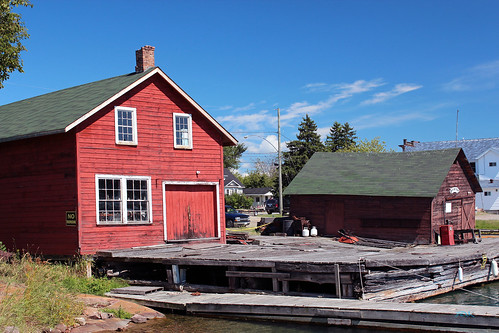 |
| Old fishing shed in Killarney, built at the end of the 19th century |
A website about Killarney’s history created by Adele Loosemore (http://www.killarneyhistory.com/) recounts one interesting story about mail delivery to Killarney:
“Killarney was on the mail route from Penetanguishene to Sault Ste. Marie...on the 25th of November 1872, John Egan, contractor for carrying the mail, despatched two Wikwemikong Indians with the Soo mail for Penetang. They were Beaubien and his son-in-law, Moses Ganewebi. They fell in a storm and made very slow headway. On the return trip, on the 18th of December following, Moses arrived here from Byng Inlet with Alexandre Proulx and Pierre Pilon. He had the following story to tell:
I and my father-in-law were walking on the new ice, a few miles past Byng Inlet, intending to get ashore at a point a little further on. The wind was increasing from the northwest. We noticed that the ice was fast drifting from shore. We both ran towards the shore, but the ice had already moved several feet away and we could not get back to the land. I jumped into the water and swam ashore to a small island about an acre in size.
My father-in-law laid the mail bags on the ice, sat down on them, and waving his hands to me, bid me good-bye forever, with compliments for his friends of Shebwaonaning (Killarney) and Wikwemikong. As the ice was drifting fast, poor Beaubien was soon lost out of sight.
I remained on the island for two days and two nights without food or fire, tramping and running all this time to keep from freezing. At last some new ice formed, and with the help of two poles, I crawled on my hands and knees to the mainland and reached Byng Inlet, where I was well taken care of for a few days, and here I am.
In August, 1837, during her canoe journey from Sault Ste. Marie to Toronto, Anna B. Jameson passed through the narrow channel between George Island and the mainland, where the present day town of Killarney is located. This is how she described this event:
“Killarney was on the mail route from Penetanguishene to Sault Ste. Marie...on the 25th of November 1872, John Egan, contractor for carrying the mail, despatched two Wikwemikong Indians with the Soo mail for Penetang. They were Beaubien and his son-in-law, Moses Ganewebi. They fell in a storm and made very slow headway. On the return trip, on the 18th of December following, Moses arrived here from Byng Inlet with Alexandre Proulx and Pierre Pilon. He had the following story to tell:
I and my father-in-law were walking on the new ice, a few miles past Byng Inlet, intending to get ashore at a point a little further on. The wind was increasing from the northwest. We noticed that the ice was fast drifting from shore. We both ran towards the shore, but the ice had already moved several feet away and we could not get back to the land. I jumped into the water and swam ashore to a small island about an acre in size.
My father-in-law laid the mail bags on the ice, sat down on them, and waving his hands to me, bid me good-bye forever, with compliments for his friends of Shebwaonaning (Killarney) and Wikwemikong. As the ice was drifting fast, poor Beaubien was soon lost out of sight.
I remained on the island for two days and two nights without food or fire, tramping and running all this time to keep from freezing. At last some new ice formed, and with the help of two poles, I crawled on my hands and knees to the mainland and reached Byng Inlet, where I was well taken care of for a few days, and here I am.
In August, 1837, during her canoe journey from Sault Ste. Marie to Toronto, Anna B. Jameson passed through the narrow channel between George Island and the mainland, where the present day town of Killarney is located. This is how she described this event:
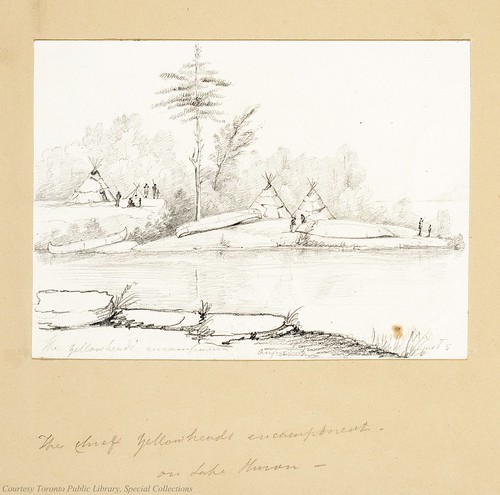 |
| "The chief Yellowhead Encampment on Lake Huron"--sketch by Anna B. Jameson depicting Killarney Channel and the encampment she described in her book |
“About sunset, we came to the hut of a fur-trader, whose name I think, was Lemorondiere. It was on the shore of a beautiful channel running between the mainland and a large island. On a neighboring point, Wai,sow,win,de,bay (the Yellow-head) and his people were building their wigwams for the night. The appearance was most picturesque, particularly when the camp fires were lighted and the night came on.”
And so 175 years later we were now sitting on the shores of this channel and enjoying its beauty! Later we went to a museum in Killarney (located vis-à-vis the Post Office and next to an old jail) and spent almost an hour there, looking at many artifacts, photos and historical records. Later that day we visited the cemetery, located at the back of an impressive Roman Catholic Church resembling a lighthouse. A lot of people buried there were the descendants of the founder of Killarney and had the surname “La Morandiere” (we were told that the town’s founder, Etienne Augustin de la Morandiere, was also buried there, but we could not locate his grave; later I read that he was buried in Wikwemikong on Manitoulin Island). We found a grave of Nancy Solomon Pitfield—there was a small park named after her (which last year we used to launch our canoe), with the following inscription on a plaque attached to a boulder in the park:
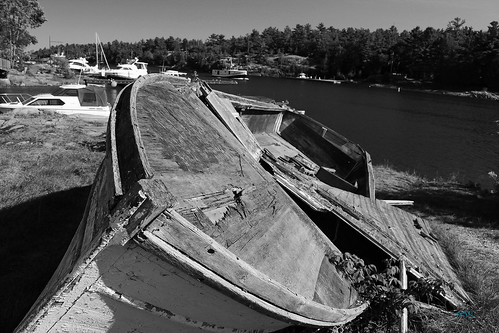 |
| Killarney Channel |
Nancy Solomon Pitfield, October 21, 1885—August 11, 1965. For nearly half a century, “Aunt” Nancy Pitfield was Killarney’s angel of mercy. Born in this community, she studied nursing in Winnipeg and Montreal, where she graduated from Hotel Dieu Hospital. She returned to this then isolated village and married George Pitfield in 1919. She dealt with grave illnesses and accidents without the aid of a doctor, sometimes reaching outlying patients by dogsled or snowshoes. She expertly set dislocated hips and knees, delivered 512 babies, and once performed an emergency appendectomy, always with an encouraging word and a smile. Remembered always for her dedication and love for people.
There were many Solomons buried in the cemetery and most likely Solomon Island was named after one of them. According to the website about the history of Killarney, http://www.killarneyhistory.com/, the forefather of all the Solomons of Killarney was Ezekiel Solomon, the first Jewish immigrant to settle in what is now the U.S. state of Michigan. He was born around 1735 in Berlin, Germany and arrived at Mackinac Island, in the narrows between Lakes Michigan and Huron, in 1761 and quickly established himself as a fur trader. By 1765, he and his partner were operating the Solomon-Levy Trading House at Fort Michilimackinac, then a British military post. In 1779, he joined a group of businessmen to open a general store there. Ezekiel married Louise Dubois, also called Okimabinesikwe, a Roman Catholic, and they had six children. As the Americans and British battled over various lands at the head of the Lakes, Ezekiel re-established his business, first at St. Joseph Island, then Drummond Island, to avoid coming under American rule. Ezekiel died around 1808. All of the locations at which he had operated his businesses were eventually turned over to the Americans. In 1828, the Solomons still living at Drummond Island migrated to Penetanguishene when the British garrison transferred there. The Killarney Solomons are all descended from William (third son of Ezekiel and Louise) and Agibicocona.
There were many Solomons buried in the cemetery and most likely Solomon Island was named after one of them. According to the website about the history of Killarney, http://www.killarneyhistory.com/, the forefather of all the Solomons of Killarney was Ezekiel Solomon, the first Jewish immigrant to settle in what is now the U.S. state of Michigan. He was born around 1735 in Berlin, Germany and arrived at Mackinac Island, in the narrows between Lakes Michigan and Huron, in 1761 and quickly established himself as a fur trader. By 1765, he and his partner were operating the Solomon-Levy Trading House at Fort Michilimackinac, then a British military post. In 1779, he joined a group of businessmen to open a general store there. Ezekiel married Louise Dubois, also called Okimabinesikwe, a Roman Catholic, and they had six children. As the Americans and British battled over various lands at the head of the Lakes, Ezekiel re-established his business, first at St. Joseph Island, then Drummond Island, to avoid coming under American rule. Ezekiel died around 1808. All of the locations at which he had operated his businesses were eventually turned over to the Americans. In 1828, the Solomons still living at Drummond Island migrated to Penetanguishene when the British garrison transferred there. The Killarney Solomons are all descended from William (third son of Ezekiel and Louise) and Agibicocona.
We also went to Pitfield’s, the town’s only general store and later to Killarney Mountain Lodge (originally built as a trucking magnate retreat, it saw a lot of famous guests, Jimmy Hoffa of Teamsters fame being one of them). As I was waiting for Catherine in the restaurant lounge, I noticed a bulky (260 pages), hardcover book on history of Killarney area, “Georgian Bay Jewel: The Killarney Story” by Margaret E. Derry. After having a browse through it, I found it so fascinating that later Catherine bought it for me as my birthday gift (and I was not disappointed—I spent hours perusing this fascinating book and admiring many captivating photographs, paintings and sketches that greatly enriched my reading experience; it can be ordered from http://www.poplarlane.net/).
We drove back to the Chikanishing Creek, loaded the canoe and in no time were paddling back to our campsite—this time the wind was rather light and we did not have to worry about anything happening to the canoe!
We drove back to the Chikanishing Creek, loaded the canoe and in no time were paddling back to our campsite—this time the wind was rather light and we did not have to worry about anything happening to the canoe!
The next day (August 22, 2012) we were planning to go to Martins Island in the evening to look for the geocache, but the wind was too strong—the trip would require paddling on a few stretches of open water. We decided to go to bed early, get up in the morning the next day and go paddling.
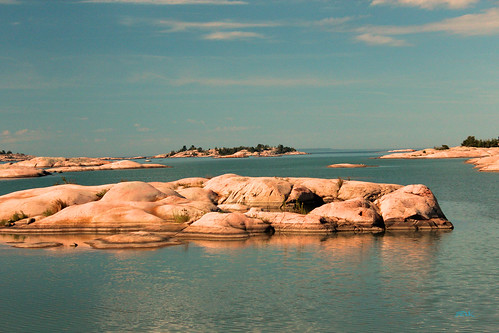 |
| View from our campsite on Jill Island in the morning |
Indeed, we were up before 06:00 am. There was no wind whatsoever and we sat on the rock for a while, having breakfast and enjoying the sunrise, the mirror-like water surface and the surrounding landscape. Again, I remembered how Anna Brownell Jameson described having breakfast on the morning after leaving Killarney and canoeing somewhere close to the area we were staying in:
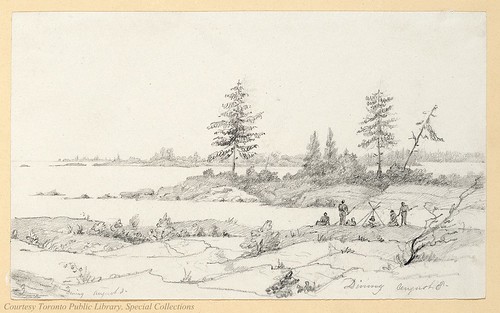 |
| Sketch by Anna B. Jameson "Dinning". It was made on August 8, 1837, just after she left the site of Killarney Channel |
“We breakfasted this morning on a little island of exceeding beauty, rising precipitately from the water. In front we had the open lake, lying blue, and bright, and serene, under the morning sky, and the eastern extremity of the Manitoolin Island; and islands all around as far as we could see. The feeling of remoteness, of the profound solitude, added to the sentiment of beauty: it was nature in her first freshness and innocence, as she came from the hand of her Maker, and before she had been sighed upon by humanity—defiled at once, and sanctified by the contact. Our little island abounded with beautiful shrubs, flowers, green mosses, and scarlet lichens. I found a tiny recess, where I made my bath and toilette very comfortably. On returning, I found breakfast laid on a piece of rock; my seat, with my pillow and cloak all nicely arranged, and a bouquet of flowers lying on it. This was a never-failing ‘galanterie’, sometimes from one, sometimes from another of my numerous cavaliers’”.
Who knows, maybe it was the island we were staying on?
Before 07:00 am we were on the water and commenced paddling towards Lowe Island, which was 10 minutes from our campsite. On this island, as well as on another island just south-west of it, stood some dwellings. We tried to paddle across the channel between the islands, but it was too shallow, so we went around the small island and entered the ‘narrows’ from the other direction. There was a beaver lodge—and a beaver lazily swimming nearby. The building on Lowe Island resembled a small resort, yet nobody was there. Perhaps it was a private fishing/hunting club, which member can use whenever they want.
Who knows, maybe it was the island we were staying on?
Before 07:00 am we were on the water and commenced paddling towards Lowe Island, which was 10 minutes from our campsite. On this island, as well as on another island just south-west of it, stood some dwellings. We tried to paddle across the channel between the islands, but it was too shallow, so we went around the small island and entered the ‘narrows’ from the other direction. There was a beaver lodge—and a beaver lazily swimming nearby. The building on Lowe Island resembled a small resort, yet nobody was there. Perhaps it was a private fishing/hunting club, which member can use whenever they want.
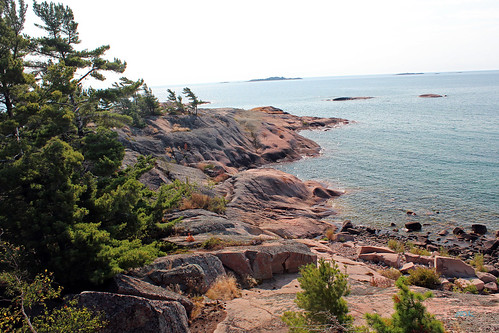 |
| Martins Island |
Next we paddled to East Fox Island and then towards Martins Island. Last year, having spent a couple of nights on Solomon Island due to the windy weather, we finally paddled early in the morning to West Fox Island and took almost exactly the same route as we were taking today. It is difficult to describe the beauty of those small, round islands, popping out of the water as if pushed by volcanic explosions, polished and smooth, resembling water slides. There were a few campers at several location of Martins Island. We got into a big bay on the east side of Martins Island; there were plenty of stones and rocks along the shore, as well as it was very slippery, so we had to be careful getting out of the canoe and pulling the canoe on land. Once it was secured (well, we did lose it twice before, it simply floated away!), we walked up a steep but short incline where the geocache was located. The view was awesome—we saw West Fox Island and our last year’s campsite, as well as Green Island and many other rocky islands. The geocache, called “The Spider Tree”, was supposed to be (according to the GPS coordinates) at the location of a pine tree whose branches resembled a spider. There were plenty of cracks and crevices around the tree, so I thought the cache was located somewhere there. Since there were two campers nearby, we did not want to disturb them—undoubtedly they were wondering what the heck we were doing! Anyway, we spent over one hour searching every nook, crevice, crack and cranny around the tree, but to no avail. We checked the tree itself—as well as examined adjoining trees and crevices, but found no trace of anything resembling a geocache. Unfortunately, I forgot to bring a printout of the geocache’s description (which actually said “white pine”), but I do not know if it would have helped me—after all, I searched the area in the 5-10 meters from the GPS coordinates. Well, eventually we did not find it, but it was absolutely worth to make this jaunt on such a beautiful morning! We descended the hill to the canoe and paddled around Martins Island, stopping for a moment near a good spot for a campsite (Catherine had surveyed it last year) and then leisurely paddled back to the campsite.
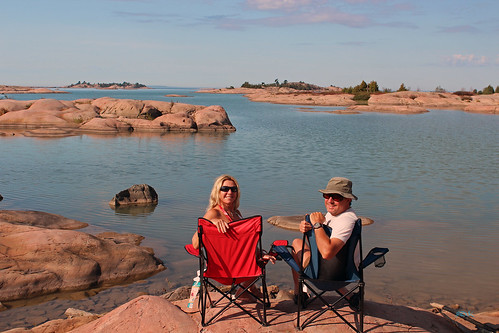 |
| Relaxing on Jill Island... simply Paradise! |
We decided to pack up later today and paddle to another campsite in the evening (the same one we stayed on two years ago in 2010) on Philip Edward Island, just across from the mouth of the Chikanishing Creek. We left our charming campsite at about 05:00 and arrived at the new campsite at about 06:30 pm. The water level was visibly lower—there were two big rocks sticking out of the water—I remember that two years ago they were underwater. I was very disappointed when I saw the big fire pit—there was plenty of refuse, broken beer bottles and other garbage inside; it was in such a bad shape that another fire pit was built meters from the big one. Yet even the ‘new’ one already had plenty of glass inside, which we carefully removed. It reminded me of one of “The Simpsons” episodes (“Trash of the Titans”). Homer became the Sanitation Commissioner and of course, soon the results of his disastrous reign were evident! To make the story short, in a little while the city of Springfield was wallowing in the trash. Since no one was willing to clean up the trash, the mayor simply decided to move the entire town a few miles down the road. Prophetically, Lisa predicted that once Springfield moved to the new location, its residents would begin littering all over again.
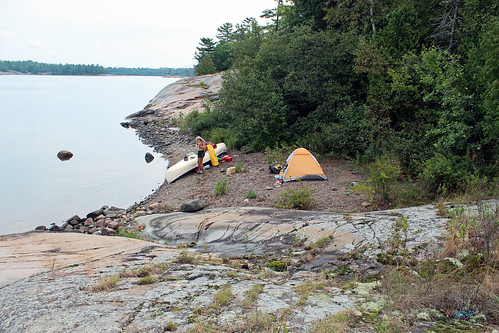 |
| Our last campsite on Philip Edward Island. We camped here at the end of our trip around Philip Edward Island in August, 2010 |
We quickly set up the small, emergency tent, put our mattresses and sleeping bags inside, hopped into the canoe, paddled to the car and drove to the town of Killarney. Again we had fish and chips at Herbert Fisheries as well as I reserved 2 lb. of smoked fish, to be picked up tomorrow. I spoke to the restaurant’s owner’s brother who told me that commercial fishermen had to buy special ‘quotas’ which allowed them to catch a certain quantity of fish every year—but the restaurant’s owner had plenty of quotas, he assured me—the restaurant was not going to run out of fish! In fact, it was the only commercial fishing operation in Killarney—difficult to believe, as fishing was the main business in this town in the past! Normally the fishermen were catching White Fish (which was served in the restaurant), but sometimes they accidentally caught such fish as pike or even sturgeon—pikes were released as they were game fish; sturgeon fishing, even for recreational fishermen, was banned in Ontario several years ago and thus they had to be released (not that I know anyone who has ever caught a sturgeon or actively tried to catch one). Incidentally, sturgeon fishing was very popular in Ontario in the 19th and early 20th century, some specimens reached many meters in length and weighted hundreds of kilograms. According to several witnesses, not long ago there were sightings of the so-called “Mazinaw Lake Monster” in Lake Mazinaw in Bon Echo Provincial Park in Ontario. Some biologists think that the sightings might have been genuine—Lake Mazinaw is one of the deepest lakes in southern Ontario (about 180 meters deep) and it is possible for a huge sturgeon to still live there.
When I was in Killarney two days ago, I saw a few huge otters, playing around the fishing boat—they a little tame (yet still wild—it was just enough for me to take a look at their teeth) and no doubt, fed on the discarded fish parts! This time the fishing boat, docked at the back of the restaurant, was thoroughly cleaned and empty, ready to set out on Georgian Bay in the morning.
It was almost 08:00 pm and everything in Killarney was closing. We walked down the main street and then drove a little on several side streets. Apparently, most businesses close down for the winter and their owners leave town, either going to bigger Canadian cities, or migrating to the southern, warmer parts of the USA, as hundreds of thousands of Canadians, so called ‘snow birds’, do every year.
When we arrived at the parking lot, it was almost dark and nobody else was around. As we were loading the canoe, using our headlights, we heard a sound of a motorboat engine and finally discerned in the darkness a motorboat slowly moving towards the dock on the Chikanishing Creek; apparently neither the boat nor its several occupants had any flashlights (???) and they seemingly had problems with getting it from the water and placing on a truck trailer. When we finally parked the car and got into the canoe, it was 09:15 pm and completely dark. The wind was negligible and we did not see or hear any boat lights around, only some navigational lights kept flashing at regular intervals. Nevertheless we wore our lit headlights, just in case, and paddled towards the location of the campsite (I was glad I had a lit GPS unit—normally we leave a cheap flashing LED light on the campsite which guides us to the right location). Eventually we reached the campsite, but not before the canoe hit one of the two rocks sticking out of the water! In no time I started a fire and we grilled a bunch of sausages purchased the other day from Pitfield’s! It was our last night and we really enjoyed sitting around the fire.
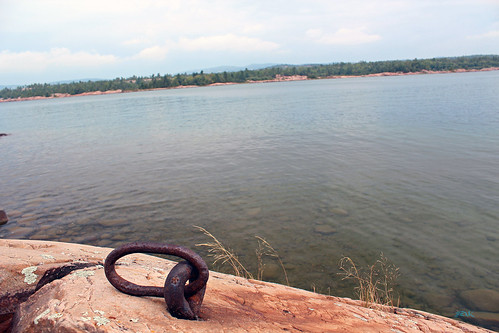 |
| Old ring at our campsite on Philip Edward Island--such rings were used over 100 years ago by logging companies |
Next day we were up in the late morning and since most of our stuff had already been loaded into the car, there was not that much to pack up. We departed after noon and paddled along the other shore for a while, where the Chikanishing Trail ran. Catherine had wanted several times to hike the trail, but never had the time to do it. At the parking lot there were a lot of people launching their boats or taking them out. Once we loaded the car (which is never easy—for some inexplicable reasons, we always seem to have more stuff at the end of our trip than we do at the beginning), we drove to Killarney. I picked up my smoked fish from Hebert Fisheries, Catherine bought one portion of French fries and cold beer which we had while sitting on the dock. On our way back we stopped at Killarney Park, had a shower and changed our clothes. Catherine also bought me the book about Killarney, “Georgian Bay Jewel: The Killarney Story” by Margaret E. Derry and later wrote a nice dedication for my 50th birthday.
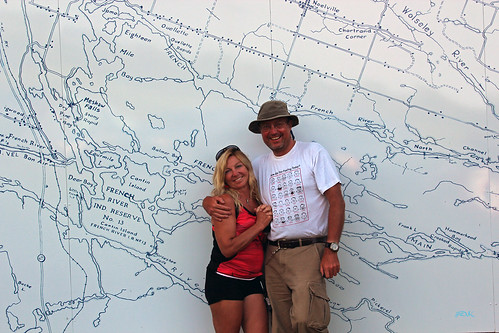 |
| The new map of the French River area near the Hungry Bear Restaurant |
We stopped (again!) at the Hungry Bear Restaurant, where we met the Hungry Bear and Blueberry Hound. I had just soup with bun and a cup of coffee. We also went to the Trading Post—indeed, some of the items it had were absolutely amazing (like cups/plates/ties with Benjamin Chee Chee paintings, carvings, original T-shirts, books, videos), but in my opinion they were hugely overpriced. The ride home was quite good—however, we saw a very old bus (which was more fit to be in a museum than driving on a main road) which was using the 90 km/h highway and crawling at a speed of maybe 20 km/h, some drivers had to do a lot of breaking in order not to hit it—and then on highway #400, just before the King Road exit, we ran into a traffic jam caused by road construction. I remember seeing a truck towing a boat with an outboard motor, it slowly passed me on the left and I was looking at the boat for a while. Just minutes later, as everybody was slowing down due to the traffic congestion, evidently somebody did not manage to bring his (or her?) car to the stop and rear-ended the trailer with the boat. I had no idea if there was any serious damage, but I did see some people getting from their cars and assessing the situation… since the accident occurred just as the King Street exit lane commenced, I decided to exit and took King Street which eventually got us home.
 |
| Enjoying ice-cream at the parking lot of the Hungry Bear Restaurant and French River Trading Post |
It was one of our longest excursions, comprised of two separate trips, in one of the most beautiful regions of Ontario. We will certainly paddle on the French River and Georgian Bay again-who knows, if the weather is good, maybe even this year?
More photos from this trip: http://www.flickr.com/photos/jack_1962/sets/72157631846528711/
Blog po polsku/in Polish: http://ontario-nature-polish.blogspot.ca/2012/08/na-kanu-na-zatoce-georgian-bay-kolo.html
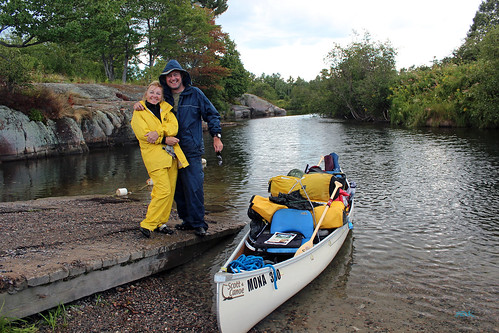
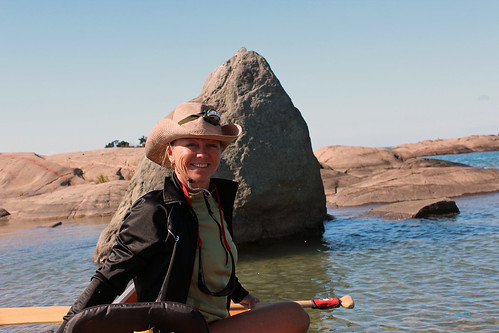
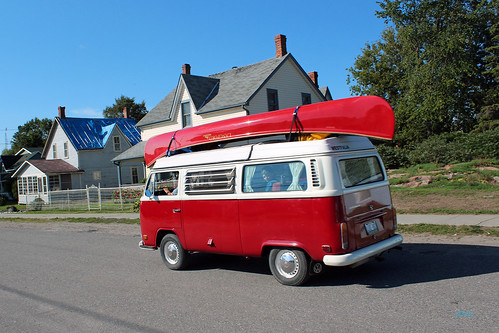
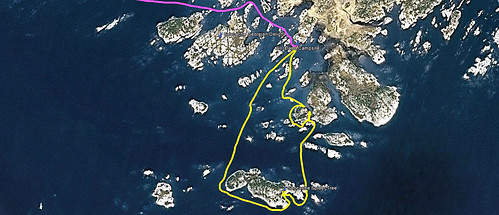

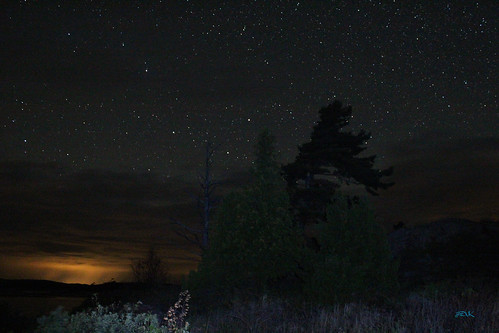
Hi Jack, Thank you very much for such a detailed and vivid descriptions. We did French River Delta loop last July (http://yaktraveller.blogspot.ca/2012/07/trip-4-french-river-delta-loop-with.html) and just were thinking of something for the next summer, when found your "poetic" reports on the Philip Edward Island circumnavigation. Now we're preparing to this route. The main discussion is around how much red wine to take on board :-)
ReplyDeleteOne technical question: did you use solar battery charger for your GPS? and what kind of radio does one need to listen the local weather forecast? Thank you, Boris
P.S. Chytalem pana blog po-polsku and enjoy it very much, (znam za wino s textu polskego, nema tego w English version). Unfortunately cannot write in Polish, so forced to use English.
Thanks for your comments-and sorry for the late reply, I've been extremely busy. I will certainly read your blog. I think 0.75 l. of red wine per person per day is enough ;) No, I did not use a solar battery, just regular batteries (or sometimes recheargeable). I have a marine radio which also allows me to listen to the weather reports (in addition to transmitting signals in case of emergency/urgency). In addition, my walkie-talkie has a built-in weather channel. If you have any questions, let me know!
ReplyDelete